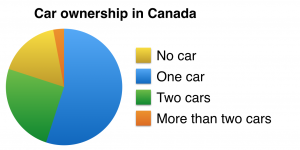Pie Chart-RRB
Pie Chart
A pie Chart is a type of graph in which a circle is divided into sectors that each represent a proportion of the whole. Pie charts can be replaced in most cases by other plots such as the bar chart. The central angle of a circle is 360°. The proportion that each part bears to the whole will be corresponding proportion of 360° , which is required to be calculated.
Roughly 5 Qs are asked in the Bank Exam on Pie Charts, which generally range from being Moderate to Difficult.
It is difficult to combine more than one category in a single Pie-chart.
Within a Pie-chart, the apportionment of the various “slices” of tile “pie”is usually represented in
(a) Actual numerical values or
(b) Percentage values.
Where to use pie charts
Pie charts, unlike bar graphs and line graphs,cannot be use – The basic premise is that the pie slices sum up to a meaningful whole.
For example,if a college has five departments, and the pie chart shows the number of faculties per department, the sum of all the slices is the total number of faculties in the college.
– If the parts do not sum up to a meaningful whole, they cannot be represented in a pie chart.
It maKes no sense to represent the profit percent of five different companies in a pie chart, because they obviously don’t sum up to a meaningful data.
– The data in the slices have to mutually exclusive, they cannot overlap.
For example,if some students of class failed in English, some failed in Mathematics,we cannot represent the number of students failed in both the subjects in a pie
– Since a pie chart represents a whole,there is an indicator of something being wrong in the pie chart when the percentages do not sum up to 100%.
How to read pie charts?
Pie charts can be represented in three different forms. The values represented in sectors are proportional to their areas. Let’s look how to read data from pie charts. (i) The first and the easiest form is the one where the values are given for each sector.
Illustration

Q1. If for a certain quantity of books, the publisher has to pay Rs. 30,600 as printing cost, then what will be amount of royalty to be paid for these books?
A. Rs. 19,450
B. Rs. 21,200
C. Rs 22,950
D. rs. 26,150
Answer :Option C
Explanation
Let the amount of Royalty to be paid for these books be Rs r.
Then , 20 : 15 = 30600 :r => r = Rs. \( ( \frac{30600\times\!15}{20} )\) = Rs 22,950.
Q2. What is the central angle of the sector corresponding to the expenditure incurred on Royalty?
A. 150
B. 240
C. 540
D. 480
Answer :Option C
Explanation
Central angle corresponding to Royalty ( 15 % of 3600)
= \( ( \frac{15}{100}\times\!360 )\)0
= 540
Q3. The price of the book is marked 20% above the C.P. If the marked price of the book is Rs. 180, then what is the cost of the paper used in a single copy of the book?
A. Rs. 36
B. Rs. 37.50
C. Rs 42
D. rs. 44.25
Answer :Option B
Explanation
Clearly marked price of the book = 120% of C.P.
Also cost of paper = 25% of C.P
Let the cost of paper for a single book be Rs. n.
Then 120 :25 = 180 : n => n = Rs. \( ( \frac{25}{180}\times\!120 )\)
= Rs 37.50
Q4. If 5500 copies are published and the transportation cost on them amounts to Rs. 82500, then what should be the selling price of the book so that the publisher can earn a profit of 25%?
A. Rs . 187.50
B. Rs . 191.50
C. Rs . 175.50
D. Rs . 180
Answer :Option A
Explanation
For the publisher to earn a profit of 25%, S.P. = 125% of C. P.
Also Transportation Cost = 10% of C. P.
Let the s.P. of 5500 books be Rs. x.
Then, 10 : 125 = 82500 : x => Rs.\( ( \frac{125 \times\! 82500}{10} )\)
= Rs 10,31,250
so S.P of one book = Rs\( ( \frac{ 10,31,250}{5,500} )\)
=Rs 187.50.
Q5. Royalty on the book is less than the printing cost by
A. 5%
B. 33\( ( \frac{ 1}{5} )\)%
C. 20%
D. 25%
Answer :Option A
Explanation
Pricing cost of book = 20% of C.P.
Royalty on book = 155 of C.P.
Difference = ( 20 % of C.P) – (15% of C.P ) = 5% of C.P.
So percentage difference = \( ( \frac{Difference }{Printing \: cost}\times\! 100 )\)%
= \( ( \frac{5 \% \of \ CP }{Printing \: cost}\times\! 100 )\)% = 25%.
